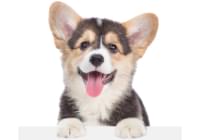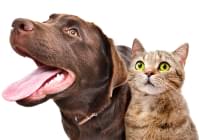Obesity in Pets
Obesity
Michael W. Stephan, D.V.M.
Juno Beach Animal Hospital
Malnutrition in dogs and cats can be a serious problem. Most of the time, it isn't the quality of the pet food that causes the problem, but the treats and extras we add to their diets. In over 90% of the cases of malnutrition in dogs and cats, the primary sign is obesity. As in their human counterparts, obese dog and cats are at much higher risk of heart disease, liver disease, crippling arthritis, and diabetes. Starting a new puppy or kitten out on the right track and developing good habits when they are young will help prevent obesity as the move in middle age and their senior years. If your pet is already over weight, there are some simple steps you can take to reduce their weight and improve their health. Some of these changes will actually improve your health as well! This week we will discuss prevention and management of obesity in dogs. Next week well tackle the more difficult issue of obesity in cats.
As in people, obesity in dogs is usually a case of more calories consumed than burned. Sometimes it may be due to an underlying thyroid condition, or other hormonal imbalance, but most of the time it is from a diet too high in fat combined with too little exercise. Unfortunately there are many ways we increase their calorie intake without realizing it.
Perhaps the greatest mistake people make in this department is mixing canned food or table food with dry food. Canned food tastes better than dry food because it has a higher fat content. The first advice I give to people with an overweight dog is to feed the same amount of food they are presently feeding, but feed the canned food or table food in one bowl and the dry food in another. I know what you are thinking! ABut he wont eat the dry food if I do that!@ And you are right. For the first few days, your dog will devour the canned food, then give a sniff at the dry food and walk away from it. Usually by the fourth or fifth day you will notice them starting to nibble at the dry food. If they are not, start reducing the amount of canned food you are feeding at each meal. When they get hungry, that dry food will start looking better and better. Dogs will not starve themselves to death! If dry food is available and they are hungry, they will eventually eat it. If they know you will break down and mix canned food or table food with it they will hold out quite a bit longer. Be firm!
The second most common way we provide extra calories to our dogs is with treats. Treats usually come in two varieties. People treats and dog treats. Some people cannot help sharing their own treats with their dog. Every time they reach for a cookie, Fido gets a cookie. Did you know that a medium size Milk Bone has 120 calories in it? That is the same number of calories that are in a Snickers bar. One Snickers bar in a day for a person might be okay, but would you allow your children to eat five or six of them a day? Most dogs will readily eat raw carrots, and will accept these as treats or rewards. If your dog will not, there are low calorie treats available with as few as thirteen calories each.
And finally, of course, there is exercise. If you can walk with your dog once or twice a day, you will both benefit. Some dogs love to swim, and a daily workout in the pool will help burn off fat. If you are not able to walk with your pet, teaching them to fetch and playing ball with them will still get them the exercise they need. Some owners have even been successful at training their dogs to run on a treadmill!
As with exercise programs for people, start your pet out with a thorough physical examination by your veterinarian. Start slowly and for short periods, and gradually increase the pace and time of the exercise. Dogs can be very prone to heat stroke, so avoid exercise in the heat of the day and keep plenty of fresh water available at all times. A conscientious program of diet and exercise can help shed those extra, unwanted pounds and help ensure a longer, healthier life for your beloved companion.





